Is Matter around us Pure?
NCERT Class 9- Science - Chapter 2-Notes-Solution-Video-PDF
NCERT-Class 9-Science-Chapter-2-Is Matter around Us Pure?-Notes
Topics to be learn :
- Substance
-
Elements,
-
Compounds and mixtures.
-
Heterogenous and homogenous mixtures,
-
Colloids and suspensions
- Tyndall Effect
- Methods of Separation
[responsivevoice voice="UK English Female" rate="0.8" pitch="0.8" buttontext="Listen to this"]
Substance :
- Anything that cannot be broken into further particles by applying any physical processes is called a Substance.
- Matter can be classified into two types of substances – Pure substances and Mixtures

Pure substance :
A substance that consists of only one type of particle is called a Pure Substance. For Example : Diamond, Salt, Sulfur, Tin.
Mixture :
- When we combine different substances into each other a mixture is formed. For Example: Lemonade is a mixture of three substances, Lemon Juice, Sugar and Water.
Question : Identify given things is mixture or a pure substance :
Water, Copper, Chocolate cake, Hydrogen, Soil, Air
Answer :
- Mixture – Chocolate cake, Soil, Air
- Pure substance – Water, Copper, Hydrogen
Difference Between Pure Substance and Mixture :

[/responsivevoice]
[responsivevoice voice="UK English Female" rate="0.8" pitch="0.8" buttontext="Listen to this"]
Types of Mixtures :
There are two categories of mixtures: Homogeneous Mixtures and Heterogeneous Mixtures.
Homogenous Mixtures :
- When we add sugar, water and lemon juice together they all uniformly mix with each other. Now it is no possible to separate these substances from the mixture. Such mixtures in which the components mix with each other uniformly are called Homogenous Mixtures.
- The ratio of compositions of homogeneous mixtures can be different.
Example: one may add two spoons of sugar in lemonade while someone else may add only one spoon of sugar in their lemonade. Still, lemonade is a homogeneous mixture.
Heterogeneous Mixtures :
- The components in a heterogeneous mixture do not completely dissolve in each other and we can separate them by physical means. In other words, the composition of such mixtures is not uniform.
Example: If we mix sand in water the sand settles down in water after some time and we can separate it by filtration.

Differences between homogeneous and heterogeneous mixtures –
| Homogenous Mixtures | Heterogeneous Mixtures |
| They have a uniform composition throughout | They have a non-uniform composition |
| We cannot separate the components of the mixture through physical processes | We can separate the components through physical processes |
| Components cannot be seen through naked eyes | Components can easily be seen through naked eyes |
| The mixture is in single phase throughout | The substances can be of two different phases and we may see separate layers of the substances |
| Example: A mixture of water and milk | Example: A mixture of oil in water |
Separating the components of a mixture :
The components of a heterogeneous mixture can be separated by
Simple methods like -hand picking , sieving , & Winnowing
Special techniques like –
- Evaporation : a mixture of salt and water or sugar and water.
- Centrifugation : Butter from curd, Fine mud particles suspended in water.
- Decantation (Using separating funnel) : Oil from water.
- Sublimation : Camphor from salt,
- Chromatography : Different pigments from an extract of flower petals.
- Distillation and fractional distillation : Separating components of Petroleum
- Magnetic separation: Iron pins from sand.
| Alloy :
An alloy is a mixture of different metals or non-metals and metals that cannot be separated from each other using physical methods. Example: Brass – Copper with up to 50% zinc Bronze – Copper with up to 12% tin However, these are considered as mixture because these show the properties of its constituents and can have variable composition. The benefit of alloys is that you can combine metals that have varying characteristics to create an end product that is stronger, more flexible, or otherwise desirable to manufacturers. Aluminum alloys are extensively used in the production of automotive engine parts. Copper alloys have excellent electrical and thermal performance, good corrosion resistance, high ductility and relatively low cost. Stainless steel alloys are used for many commercial applications such as watch straps, cutlery etc. Titanium alloys have high strength, toughness and stiffness & are used in aerospace structures |
[/responsivevoice]
[responsivevoice voice="UK English Female" rate="0.8" pitch="0.8" buttontext="Listen to this"]
A solution is nothing but a uniform mixture of two or more substances. Homogenous Mixtures are solutions.
Solution of -
- Liquid into liquid: Water and Ink
- Solid into solid:Alloys
- Gas into gas:Air
- Solid into liquid:Sugar and Water
- Solid into gas:Hydrogen and Metals
- Liquid into gas:Carbon Dioxide and Water
Solution constitutes of two types of substances, a solute and a solvent.
Solution = Solute + Solvent
Solvent: The substance in which another substance is mixed is called the Solvent.
Example, Water is a solvent in which we can mix different substances such as salt or sugar.
Solute: The substance that is added to the solvent to form a solution is called a Solute.
Example, Salt, when mixed in water, acts as a solute for the mixture.
Properties of a Solution:
- A solution is a homogenous mixture.
- We cannot see the particles of a solution through naked eyes as they as are small as 1 nanometer in diameter.
- The path of light is not visible through the solution. The particles of a solution do not scatter light through them as they are extremely small.
- We cannot separate the particles of a solution by methods of filtration.
Stable solution :
A stable solution is a solution in whose particles do not settle down if we leave the solution undisturbed for some time. This is because the particles of a stable solution are homogeneously spread.
Different Types of Solutions :
- Dilute– A solution in which the concentration of the solute is much less than that of the solvent.
Example: If we mix 1gm of salt in 500 ml of water, the salt solution thus obtained will be diluted. If we keep on adding the solute in a solution there comes a point when no more solute dissolves in the solution. This is called the Saturation Point of a Solution.

- Unsaturated Solution– A solution, in which we can add more amount of solute as it has not achieved its saturation level yet, is called an Unsaturated Solution. A dilute solution can be called as an Unsaturated Solution.
- Concentrated Solution– A solution with a large amount of solvent is called a Concentrated Solution.
- Saturated Solution– A solution in which no more solute can be added since it has already dissolved the maximum amount of solute it can is called a Saturated Solution.
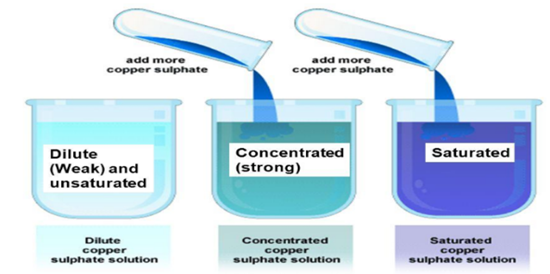
[/responsivevoice]
[responsivevoice voice="UK English Female" rate="0.8" pitch="0.8" buttontext="Listen to this"]
Concentration :
Concentration refers to the amount of a substance per defined space or can be defined as the ratio of solute in a solution to either solvent or total solution.
To calculate the concentration consider the formulae below: [/responsivevoice]
- Percent by Mass = \(\frac{\text{Mass of Solute}}{\text{Mass of Solution}}×100\)
- Percent by Volume = \(\frac{\text{Volume of Solute}}{\text{Volume of Solution}}×100\)
- Molarity (M) = \(\frac{\text{Number of Moles of Solute}}{\text{Volume of Solution in ltr}}\)
- Where, Moles of solute = \(\frac{\text{Given Mass}}{\text{Molar Mass}}\)
- Molality (m) = \(\frac{\text{Moles of Solute}}{\text{Weight of Solvent in kg}}\)
- Normality (N)= \(\frac{\text{Number of mole equivalents}}{\text{volume of solution in litres}}\)= \(\frac{\text{Mass of solute}}{\text{equivalent mass × volume of solution in Litres}}\)
- ppm (Parts Per Million) = \(\frac{\text{Mass of Solute}}{\text{Mass of Solution}}×10^6\)
- Mole Fraction SOLUTE = \(\frac{\text{Mass of Solute}}{\text{Total Mass of Solution}}\)
- Mole Fraction SOLVENT = \(\frac{\text{Mass of Solvent}}{\text{Total Mass of Solution}}\)
- \( \text{Mole Fraction}_{solute}+\text{Mole Fraction}_{solvent}\) = 1
[responsivevoice voice="UK English Female" rate="0.8" pitch="0.8" buttontext="Listen to this"]
Suspension:
A suspension is formed when two or more substances are mix in a non-uniform manner. Heterogeneous mixtures are suspensions. The solute does not mix with the solvent and can be viewed through naked eyes.
Properties of Suspensions:
- A suspension is a heterogeneous mixture.
- We can see the particles of suspensions through naked eyes.
- We can see the path of light through the particles of a suspension.
- The particles of suspension tend to settle down when left undisturbed. Then, they can be separated using filtration.
Colloids or colloidal solutions :
A colloidal solution or a colloid is a uniform solution of two or more substances. The particles are relatively very small that the solution appears as a homogeneous mixture but it is not.
Properties of colloids:
- Colloids are heterogeneous in nature.
- The particles of a colloid cannot be seen through naked eyes.
- The particles scatter a beam of light passed through a colloid and produce Tyndall effect.
- Colloids are stable in nature. The particles of colloids do not settle down if left uninterrupted.
- We cannot separate the particles of a colloid through filtration. We use a method called Centrifugation to separate the particles of a colloid.
- Colloids are heterogeneous in nature.
- The particles of a colloid cannot be seen through naked eyes.
- The particles scatter a beam of light passed through a colloid and produce Tyndall effect.
- Colloids are stable in nature. The particles of colloids do not settle down if left uninterrupted.
- We cannot separate the particles of a colloid through filtration. We use a method called Centrifugation to separate the particles of a colloid.

Tyndall Effect :
When a beam of light is passed through a colloid the particles of the colloid scatter the beam of light and we can see the path of light in the solution.
Example, when a ray of light enters a dark room it is scattered by the dust particles present in the air and we can see the path of light clearly.

Classification of Colloids :
Dispersed Phase – The dispersed particles or the solute-like components in a colloid
Dispersing Medium – The substance in which these solute-like particles are added
Based on the state of the dispersing medium colloids are classified as:
Types of Colloids
| Example | Dispersing Medium | Dispersed Substance | Colloid Type |
| Fog, Aerosol sprays | Gas | Liquid | Aerosol |
| Smoke, Airborne bacteria | Gas | Liquid | Aerosol |
| Whipped cream, Soap suds | Liquid | Gas | Foam |
| Milk, Mayonnaise | Liquid | Liquid | Emulsion |
| Paints, Clays, Gelatin | Liquid | Solid | Sol |
| Marshmallow, Styrofoam | Solid | Gas | Solid foam |
| Butter, cheese | Solid | Liquid | Solid emulsion |
| Ruby glass | Solid | Solid | Solid sol |
[/responsivevoice]
[responsivevoice voice="UK English Female" rate="0.8" pitch="0.8" buttontext="Listen to this"]
How to separate components of a mixture?
We can separate the heterogeneous mixtures into their constituents by means of physical methods like:
- Filtration
- Hand-picking
- Sieving
The components of a mixture can be separated from each other using several other techniques like:
- Evaporation
- Centrifugation
- Sublimation
- Chromatography
- Distillation
Evaporation– For separating a mixture of a non-volatile and a volatile substance
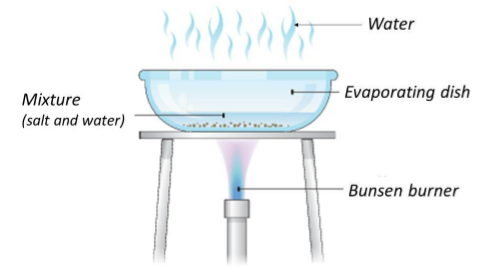
- Applications:
- Separating coloured component from the ink
- Salt from water
- Sugar from Water
- Method:
- Mix some ink into water and heat it. After some time the water will evaporate leaving behind the coloured substance.
Centrifugation– Separating dense particles from lighter particles
- Applications:
- Separating milk from cream
- Separating butter from cream
- Squeezing out water from wet clothes
- Method:
- Milk is put in a centrifuging machine or milk churner and the cream thus separates from milk.
Using a Separating funnel– To separate two immiscible liquids
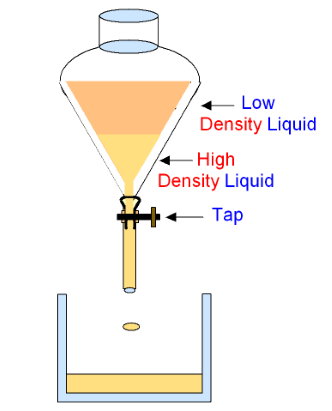
- Applications:
- Oil from water
- Iron and iron ore
- Method:
- The immiscible liquids are allowed to settle in the funnel. They soon form separate layers due to varying densities. The first liquid is allowed to flow out of the funnel and as soon as it is completely poured out, the stopcock is closed thereby separating the two liquids from each other.
Sublimation– To separate a sublimable component from a non-sublimable component

- Applications:
- Separating colour components of a dye
- Drugs from blood
- Method:
- Take a filter paper or a blotting paper and place a drop of ink at the rear end. Dip the end in water. Since ink is a mixture of two or more colors, the component of ink which is soluble in water mixes into it and then separates quickly from the other components that are less soluble in water.
Distillation– It is used for the separation of components of a mixture containing two miscible liquids that boil without decomposition and have sufficient difference in their boiling points.
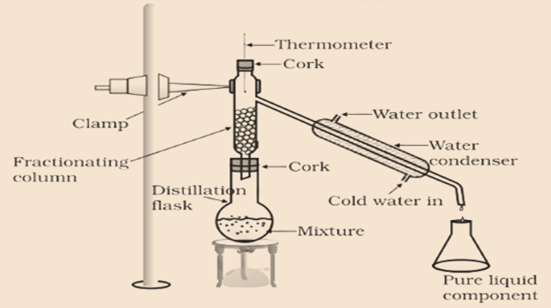
- Applications:
- Acetone and water
- Method:
- The mixture is heated in a distillation apparatus. The one substance with lower boiling point evaporates first, condenses and gets separated from the one with a higher boiling point.
- Simple Distillation– when the miscible liquids have a satisfactory difference in their boiling points
- Fractional Distillation– when the difference between the boiling points of the liquids is less than 25 K
Separating different Gases from the Air:
Method – Fractional Distillation
- Compress and cool the air by increasing the temperature and decreasing the pressure. The air turns to liquid air.
- Liquid air is warmed up slowly in a fractional distillation apparatus
- The several components of air get separated and are collected at various heights on the basis of their boiling points
Purifying Solids :
Method used – Crystallization
The crystallisation method is used to purify solids.
Applications :
- Purification of salt that we get from sea water.
- Separation of crystals of alum (phitkari) from impure samples.
Method:
- The impurities of a substance are filtered out.
- Water is evaporated to obtain a saturated solution.
- The solution is covered with filter paper and left as it is.
- After some time, the crystals of pure solid are formed.

Is evaporation better than crystallization?
Evaporation is not better than crystallization because:
- Some solid substances decompose because of excess heat. For Example, Sugar gets charred on extra heating.
- If after filtration some impurities remain in the solution they can contaminate the solid and therefore we would not obtain a pure substance.
[/responsivevoice]
[responsivevoice voice="UK English Female" rate="0.8" pitch="0.8" buttontext="Listen to this"]
Physical Property of a Substance:
Properties of a substance such as rigidity, colour, fluidity, boiling point, melting point, density and hardness which we can observe are called as Physical Properties.
Physical Change:
When physical properties of a substance change it is known as a Physical Change. When we convert a substance from one state to another, such as a solid into a liquid or vice-versa, it is also a physical change as only the physical nature of the substance changes without affecting its chemical nature.
Example: Change of ice into water. The chemical properties of water remain the same.
Chemical Property of a Substance:
The chemical nature of a substance is known as its Chemical Property such as its odour or its chemical composition.
Chemical Change:
When the chemical properties or chemical composition of a substance gets altered it is called a chemical change. It is also called as a Chemical Reaction.
Example, Burning of paper.
Types of Pure Substances
Pure substances are classified as elements and compounds
Elements
An element is the simplest form of matter. Elements cannot be broken down into further elements by chemical reactions. Elements are further characterized as Metals, Non-Metals and Metalloids
Metals – Silver, Mercury, Copper, Gold
- Metals are lustrous (shiny)
- Metals conduct heat and electricity
- Metals have a silver-grey or gold-yellow colour
- We can hammer metals and form thin sheets (Malleability)
- We can convert metals into wires (Ductility)
- Metals always produce a ringing sound if they are hit (Sonorous)
Non-Metals – Carbon, Iodine, Chlorine, Oxygen, Hydrogen
- Non-Metals do not conduct heat and electricity
- Non-Metals are not sonorous, lustrous or ductile
- Non-Metals have varied colours
Metalloids – Silicon, Germanium
They show some properties of metals and some of the non-metals.
Compounds :
It is a substance that consists of two or more substances. These substances are combined chemically with each other in fixed proportions. The properties of a compound are different than that of its constituents.
Example: Ammonium Sulphate, Sulphur Chloride, Water.
Mixtures vs. Compounds
Mixtures |
Compounds |
| Properties of a mixture Reflect the properties of the materials it contians. | Different properties from that of the elements that make up the compounds. |
| No uniform composition | Definite composition. Definite ratio/formula |
| Can be separated by physical means. | Cannot be separated by physical means. |
[/responsivevoice]
[responsivevoice voice="UK English Female" rate="0.8" pitch="0.8" buttontext="Listen to this"]
- A mixture contains more than one substance (element and/or compound) mixed in any proportion.
- Mixtures can be separated into pure substances using appropriate separation techniques.
- A solution is a homogeneous mixture of two or more substances. The major component of a solution is called the solvent, and the minor, the solute.
- The concentration of a solution is the amount of solute present per unit volume or per unit mass of the solution.
- Materials that are insoluble in a solvent and have particles that are visible to naked eyes, form a suspension. A suspension is a heterogeneous mixture.
- Colloids are heterogeneous mixtures in which the particle size is too small to be seen with the naked eye, but is big enough to scatter light. Colloids are useful in industry and daily life. The particles are called the dispersed phase and the medium in which they are distributed is called the dispersion medium.
- Pure substances can be elements or compounds. An element is a form of matter that cannot be broken down by chemical reactions into simpler substances. A compound is a substance composed of two or more different types of elements, chemically combined in a fixed proportion.
- Properties of a compound are different from its constituent elements, whereas a mixture shows the properties of its constituting elements or compounds.
[/responsivevoice]
NCERT-Class 9-Science-Chapter-2-Is Matter around Us Pure? -Exercise-Solution
Question 1:
Which separation techniques will you apply for the separation of the following?
(a) Sodium chloride from its solution in water.
(b) Ammonium chloride from a mixture containing sodium chloride and ammonium chloride.
(c) Small pieces of metal in the engine oil of a car.
(d) Different pigments from an extract of flower petals.
(e) Butter from curd.
(f) Oil from water.
(g) Tea leaves from tea.
(h) Iron pins from sand.
(i) Wheat grains from husk.
(j) Fine mud particles suspended in water.
(a) Sodium chloride from its solution in water → Evaporation
(b) Ammonium chloride from a mixture containing sodium chloride and ammonium chloride
→ Sublimation
(c) Small pieces of metal in the engine oil of a car → Centrifugation or filtration or decantation
(d) Different pigments from an extract of flower petals → Chromatography
(e) Butter from curd → Centrifugation
(f) Oil from water → Using separating funnel
(g) Tea leaves from tea → Filtration
(h) Iron pins from sand → Magnetic separation
(i) Wheat grains from husk → Winnowing
(j) Fine mud particles suspended in water → Centrifugation
Question 2:
Write the steps you would use for making tea. Use the words: solution, solvent, solute, dissolve, soluble, insoluble, filtrate and residue.
First, water is taken as a solvent in a saucer pan. This water (solvent) is allowed to boil. During heating, milk and tea leaves are added to the solvent as solutes. They form a solution. Then, the solution is poured through a strainer. The insoluble part of the solution remains on the strainer as residue. Sugar is added to the filtrate, which dissolves in the filtrate. The resulting solution is the required tea.
Question 3:
Pragya tested the solubility of three different substances at different temperatures and collected
the data as given below (results are given in the following table, as grams of substance dissolved in 100 grams of water to form a saturated solution).

(a) What mass of potassium nitrate would be needed to produce a saturated solution of potassium nitrate in 50 grams of water at 313 K?
(a) Mass of potassium nitrate needed to produce its saturated solution in 100 g of water at 313 K = 62 g k=\(\frac{62}{100}×50g\)= 31g
Mass of potassium nitrate needed to produce its saturated solution in 50 g of water at 313 K
(b) Pragya makes a saturated solution of potassium chloride in water at 353 K and leaves the solution to cool at room temperature. What would she observe as the solution cools? Explain.
(b) Crystals of potassium chloride are formed. This happens as solubility of solid decreases with
decreasing the temperature.
(c) Find the solubility of each salt at 293 K. Which salt has the highest solubility at this temperature?
(c) Solubility of each salt at 293 K Potassium nitrate 32 g per 100 g water Sodium chloride 36 g per 100 g water Potassium chloride 35 g per 100 g water Ammonium chloride 37 g per 100 g water.
Note: Solubility of a solid is that amount in gram which can be dissolved in 100 g of water (solvent) to make saturated solution at a particular temperature.
Ammonium chloride has the maximum solubility (37 g per 100 g of water) at 293 K.
(d) What is the effect of change of temperature on the solubility of a salt?
(d) Solubility of a (solid) salt decreases with decrease in temperature while it increases with rise in
temperature.
Question 4:
Explain the following giving examples:
(a) Saturated solution
(a) Saturated solution Any more solute added will settle down at the bottom of the container as a precipitate. Then, the solution obtained by dissolving 150 g of that solute in 500 g of that solvent at 300 K is said to be a saturated solution at 300 K.
A saturated solution is a solution in which the maximum amount of solute has been dissolved at a given temperature. The solution cannot dissolve beyond that amount of solute at that temperature.
Suppose 500 g of a solvent can dissolve a maximum of 150 g of a particular solute at 40°C.
(b) Pure substance
(b) Pure substance
A pure substance is a substance consisting of a single type of particles i.e., all constituent particles of the substance have the same chemical properties. For example, salt, sugar, water are pure substances.
(c) Colloid
(c) Colloid
A colloid is a heterogeneous mixture. The size of the solutes in this mixture is so small that they cannot be seen individually with naked eyes, and seems to be distributed uniformly throughout the mixture. The solute particles do not settle down when the mixture is left undisturbed. This means that colloids are quite stable.
Colloids cannot be separated by the process of filtration. They can be separated by centrifugation. Colloids show the Tyndall effect. For example, milk, butter, foam, fog, smoke, clouds.
(d) Suspension
(d) Suspension Suspension shows the Tyndall effect. The solute particles settle down when the mixture is left undisturbed. This means that suspensions are unstable. Suspensions can be separated by the method of filtration. For example, mixtures of chalk powder and water, wheat flour and water.
Suspensions are heterogeneous mixtures. The solute particles in this mixture remain suspended throughout the bulk of the medium. The particles can be seen with naked eyes.
Question 5:
Classify each of the following as a homogeneous or heterogeneous mixture.
Soda, water, wood, air, soil, vinegar, filtered tea
Homogeneous mixtures: Soda water, air, vinegar
Heterogeneous mixtures: Wood, soil, filtered tea
Question 6:
How would you confirm that a colourless liquid given to you is pure water?
Every liquid has a characteristic boiling point. Pure water has a boiling point of 100°C (373 K) at 1 atmospheric pressure. If the given colourless liquid boils at even slightly above or below 100°C, then the given liquid is not pure water. It must boil at sharp 100°C. Thus, by observing the boiling point, we can confirm whether a given colourless liquid is pure water or not.
Question 7:
Which of the following materials fall in the category of a “pure substance”?
(a) Ice
(b) Milk
(c) Iron
(d) Hydrochloric Acid
(e) Calcium oxide
(f) Mercury
(g) Brick
(h) Wood
(i) Air
The following materials fall in the category of a “pure substance”:
(a) Ice
(c) Iron
(d) Hydrochloric acid
(e) Calcium oxide
(f) Mercury
Question 8:
Identify the solutions among the following mixtures:
(a) Soil
(b) Sea water
(c) Air
(d) Coal
(e) Soda water
The following mixtures are solutions:
(b) Sea water
(c) Air
(e) Soda water
Question 9:
Which of the following will show the “Tyndall effect”?
(a) Salt solution
(b) Milk
(c) Copper sulphate solution
(d) Starch solution
Milk and starch solution will show the “Tyndall effect”.
Question 10:
Classify the following into elements, compounds and mixtures:
(a) Sodium
(b) Soil
(c) Sugar solution
(d) Silver
(e) Calcium carbonate
(f) Tin
(g) Silicon
(h) Coal
(i) Air
(j) Soap
(k) Methane
(l) Carbon dioxide
(m) Blood
Elements
Compounds
Mixtures
(a) Sodium
(e) Calcium carbonate
(b) Soil
(d) Silver
(k) Methane
(c) Sugar solution
(f) Tin
(l) Carbon dioxide
(h) Coal
(g) Silicon
(i) Air
(j) Soap
(m) Blood
Question 11:
Which of the following are chemical changes?
(a) Growth of a plant
(b) Rusting of iron
(c) Mixing of iron fillings and sand
(d) Cooking of food
(e) Digestion of food
(f) Freezing of water
(g) Burning of candle
The following changes are chemical changes:
(a) Growth of a plant
(b) Rusting of iron
(d) Cooking of food
(e) Digestion of food
(g) Burning of candle
Question 1:
What is meant by a pure substance?
A pure substance is the one that consists of a single type of particles, i.e., all constituent particles of
the substance have the same chemical nature. Pure substances can be classified as elements or
compounds.
Question 2:
List the points of differences between homogeneous and heterogeneous mixtures.
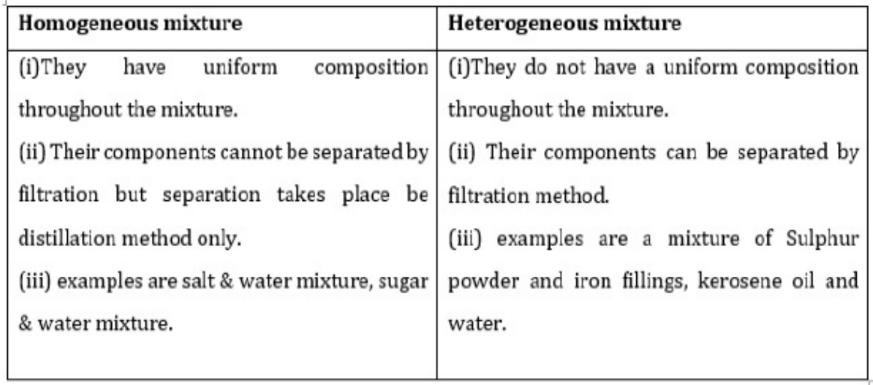
Question 1:
Differentiate between homogeneous and heterogeneous mixtures with examples.
Homogeneous
Heterogeneous
(1) They have uniform composition throughout the mixture.
(1) They do not have uniform composition
throughout the mixture.
(2) These components cannot be separated by
filtration hut separation takes place by
distillation method only.(2) Their components can by separated by
Filtration method.
Examples are salt & water mixture, Sugar & water mixture,
Examples are mixture of Sulphur powder and iron fillings, kerosene oil and water.
Question 2:
How are sol, solution and suspension different from each other?
Homogeneous mixture
Heterogeneous mixture
Uniform composition throughout
Non-uniform composition throughout
Constituents cannot be separated by simple
physical meansConstituents can be separated by simple
physical means
E.g., mixtures of salt in water, sugar in water, copper sulphate in water, iodine in alcohol, alloy, and air
E.g., composition of mixtures of sodium chloride and iron fillings, salt and sulphur, oil and water, chalk powder in water, wheat flour in water, milk and water
Question 2:
How are sol, solution and suspension different from each other?
Sol (Colloid)
Solution
Suspension
Heterogeneous mixture
Homogeneous mixture
Heterogeneous mixture
Solute particles cannot be seen with the naked eye
Solute particles cannot be seen with the naked eye
Solute particles can be seen with the naked eye
Spread uniformly throughout the mixture
Spread uniformly throughout the mixture
Suspended throughout the the mixture
Tyndall effect is observed
Tyndall effect is not
observed Tyndall effect is observed
E.g., milk of magnesia
E.g., salt in water, sugar in water, iodine in alcohol, alloy
E.g., chalk powder and water, wheat flour and water
Question 3:
To make a saturated solution, 36 g of sodium chloride is dissolved in 100 g of water at 293 K. Find
its concentration at this temperature.
Given, = \(\frac{\text{Mass of Solute}}{\text{Mass of Solvent}}×100%\) = \(\frac{36}{136}×100%\) = 26.47%
Mass of solute (here, sodium chloride) = 36 g
Mass of solvent (here, water) = 100 g
Then, mass of solution = Mass of solute + Mass of solvent
Therefore mass of solution = (36 + 100) g = 136 g
Therefore, concentration (mass by mass percentage) of the solution
Question 1:
How will you separate a mixture containing kerosene and petrol (difference in their boiling points is more than 25°C), which are miscible with each other?
A mixture of two miscible liquids having a difference in their boiling points more than 25°C can be separated by the method of simple distillation. Thus, kerosene and petrol having a difference in their boiling points more than 25°C can be separated by simple distillation. The apparatus is arranged as shown below: The mixture of kerosene and petrol is taken in a distillation flask with a thermometer fitted with the flask.
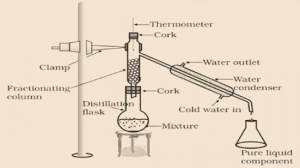
• Then, the mixture is heated slowly.
• The thermometer should be watched simultaneously.
• Kerosene will vapourise and condense in the water condenser.
• The condensed kerosene is then collected from the condenser outlet, whereas petrol is
left behind in the distillation flask.
Question 2:
Name the technique to separate
(i) butter from curd
(ii) salt from sea-water
(iii) camphor from salt
(i) Butter can be separated from curd by centrifugation.
(ii) Salt can be separated from sea-water by evaporation.
(iii) Camphor can be separated from salt by sublimation.
Question 3:
What type of mixtures is separated by the technique of crystallization?
By the technique of crystallization, pure solids are separated from impurities. For example, salt obtained from sea is separated from impurities; crystals of alum (Phitkari) are separated from impure samples.
Question 1:
Classify the following as chemical or physical changes:
• Cutting of trees
• Melting of butter in a pan
• Rusting of almirah
• Boiling of water to form steam
• Passing of electric current through water, and water breaking down into hydrogen and oxygen gas
• Dissolving common salt in water
• Making a fruit salad with raw fruits
• Burning of paper and wood
• Cutting of trees: Physical change
• Melting of butter in a pan: Physical change
• Rusting of almirah: Chemical change
• Boiling of water to form steam: Physical change
• Passing of electric current through water, and water breaking down into hydrogen and oxygen gas: Chemical change
• Dissolving common salt in water: Physical change
• Making a fruit salad with raw fruits: Physical change
• Burning of paper and wood: Chemical change
Question 2:
Try segregating the things around you as pure substances or mixtures.
Pure substance: Water, salt, sugar
Mixture: Salt water, soil, wood, air, cold drink, rubber, sponge, fog, milk, butter, clothes, food
NCERT-Class 9-Science-Chapter-2-Is Matter around Us Pure?-Videos
Click on link to open video
1- [video_lightbox_youtube video_id="dRIKuLVW3-s&rel=0" width="640" height="520" start="10" anchor="Full Chapter"]